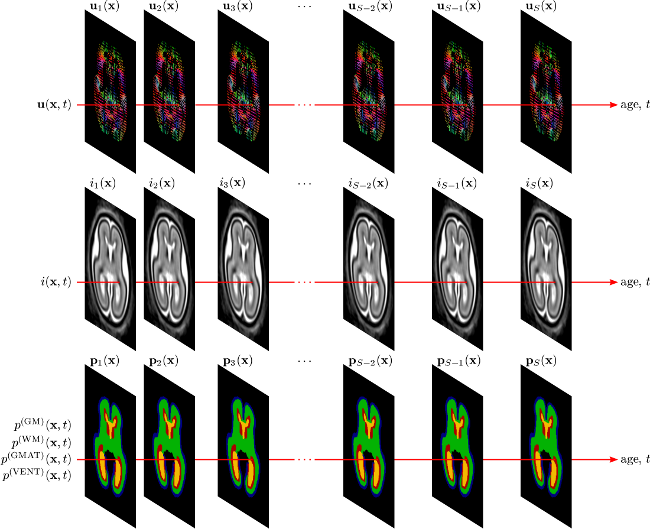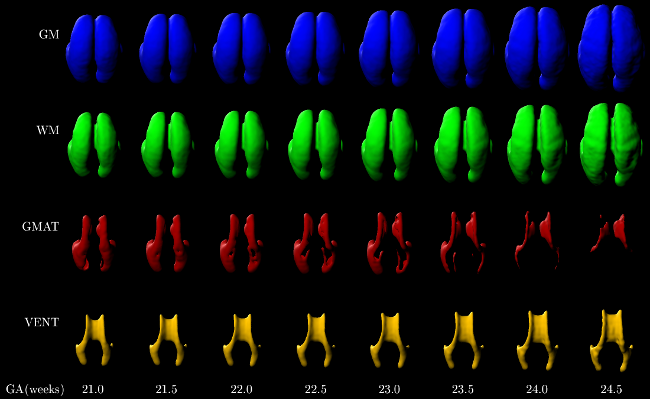Spatiotemporal atlas of the fetal brain
MR imaging data
MR imaging was performed on a 1.5T scanner (GE Healthcare, Milwaukee, WI) for 40 fetuses with normal brain development at 20.57-27.86 gestational weeks. For each subject, multiple stacks of single-shot fast spin-echo (SSFSE) T2-weighted (T2w) slice images (pixel size 1mm × 1mm, slice thickness ˜3mm) were acquired in the approximately axial, sagittal and coronal planes with respect to the fetal brain. After acquisition, image stacks of each subject were registered using the slice intersection motion correction (SIMC) technique to account for spontaneous fetal movement during scanning and reconstructed into 3D volumes with isotropic voxel size of 0.5mm. Reconstructed volumes were manually segmented into regions of developing cortical gray matter (cortical plate, CP), developing "white matter" (WM) including periventricular, subventricular, intermediate and suplate zones, the germinal matrix (GMAT), ventricles (VENT) and deep gray nuclei (DG) including basal ganglia, basal forebrain and thalamus.
Methods
In order to accurately relate data from multiple fetal subjects at different gestational ages, we need to define meaningful and consistent mapping between anatomies with different shapes and tissue morphologies. Due to limited contrast of T2w MR images used in clinical practice, there is a substantial intensity overlap between tissues in the growing fetal brain, especially between developing cortical gray matter and the germinal matrix. As this may cause incorrect alignment of developing tissues during intensity-based registration, we take advantage of existing manual segmentations of all subjects and performgroupwise registration of tissue maps rather than MR intensity images. Unlike fully data-driven approaches, this allows us to resolve registration ambiguities between different tissue types that appear with very similar intensities on T2w MR images.

After registration, we construct a continuous spatiotemporal atlas of shape, MR intensity and tissue probability capable of representing the fetal brain anatomy at any given gestational age covered by the atlas. For each voxel of the atlas space, we use the gestational age as an independent variable and model age-related changes in brain tissue probabilities using a temporal polynomial. In a similar fashion, we create spatiotemporal models of MR intensity, shape and global scale changes to build a complete four-dimensional atlas of the fetal brain anatomy.
Results

Age-specific tissue probability maps for developing white matter (WM) and the germinal matrix (GMAT) generated in the average space from a spatiotemporal atlas with quadratic temporal models of tissue probability.

3D visualization of the main tissue boundaries in the fetal brain for gestational ages ranging from 21.0 to 24.5 weeks. The geometry of each age-specific surface was derived from a spatiotemporal atlas with quadratic temporal models of size, shape and tissue probability.
Application to atlas-based tissue segmentation
Age-specific MR intensity templates and corresponding tissue probability maps generated from this continuous spatiotemporal atlas can be applied for improved automatic atlas-based segmentation of developing tissues in MR images of the fetal brain.
Download
If you would like to use this spatiotemporal atlas of the fetal brain in your research, please email us!
References
P. A. Habas, K. Kim, J. M. Corbett-Detig, F. Rousseau, O. A. Glenn, A. J. Barkovich, and C. Studholme, A spatiotemporal atlas of MR intensity, tissue probability and shape of the fetal brain with application to segmentation," Neuroimage, vol. 53, no. 2, pp. 460-470, November 2010.
P. A. Habas, K. Kim, F. Rousseau, O. A. Glenn, A. J. Barkovich, and C. Studholme, "A spatio-temporal atlas of the human fetal brain with application to tissue segmentation," in Medical Image Computing and Computer-Assisted Intervention, LNCS, vol. 5761, part I, pp. 289-296, September 2009.
![[UW Pediatrics]](/bicg/images/uwp24.jpg)
